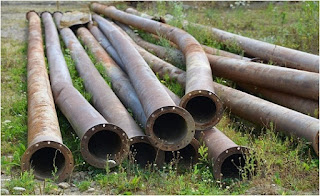Line pipe is used in various situations where a non-solid material (i.e. gas or liquid) is transported over a large distance. As a type of steel pipe, it is utilized across a number of various industries. From water and sewage to oil and gas, even mineral slurry; pipelines are essential for a wide range of resources we consume any given day of the week.
Water & Sewage:
Water and sewage pipelines are imperative for administering a hygienic and sterile water supply which includes impeding the spread of viruses and diseases. In order to avoid being structurally compromised, water and sewage pipelines must be able to defy both internal and external forces. These forces may consist of internal stress from water pressure, external stress from the surrounding geographical features and even corrosion. Typically, this type of line pipe used to move a flow of fresh water.
Oil & Gas:
Perhaps the most evident use for line pipe is in the oil and natural gas industry. Subject to transport large volumes of natural resources, certain types of pipelines are entrusted to fulfill a certain purpose. In the oil and natural gas industries, stretches of line pipe are referred to as gathering lines. This type of line pipe moves oil and gas from where it uncovered to a larger pipeline or even a storage facility. Natural gas producers also use another version of line pipe called “trunk lines.” Generally a steel pipe larger in diameter, trunks lines haul large volumes of natural gas through what is called a transmission pipeline system.
Mineral Slurry:
Seamless or welded line pipe is generally the type of steel pipe utilized by the mining industry due to its versatile nature. More often than not the application will determine the type of line pipe used. Internal pipe coatings are also determined by the project in which they will be used for. Along with transporting mineral slurry, these pipelines are utilized to carry treated and untreated water for urban water supply systems.
Conclusion:
There are a number of various daily applications for line pipe that go unnoticed by the general population. These variations are line pipe are considered to be instrumental in providing valuable resources necessary to continue on with everyday life.
Water & Sewage:
Water and sewage pipelines are imperative for administering a hygienic and sterile water supply which includes impeding the spread of viruses and diseases. In order to avoid being structurally compromised, water and sewage pipelines must be able to defy both internal and external forces. These forces may consist of internal stress from water pressure, external stress from the surrounding geographical features and even corrosion. Typically, this type of line pipe used to move a flow of fresh water.
Oil & Gas:
Perhaps the most evident use for line pipe is in the oil and natural gas industry. Subject to transport large volumes of natural resources, certain types of pipelines are entrusted to fulfill a certain purpose. In the oil and natural gas industries, stretches of line pipe are referred to as gathering lines. This type of line pipe moves oil and gas from where it uncovered to a larger pipeline or even a storage facility. Natural gas producers also use another version of line pipe called “trunk lines.” Generally a steel pipe larger in diameter, trunks lines haul large volumes of natural gas through what is called a transmission pipeline system.
Mineral Slurry:
Seamless or welded line pipe is generally the type of steel pipe utilized by the mining industry due to its versatile nature. More often than not the application will determine the type of line pipe used. Internal pipe coatings are also determined by the project in which they will be used for. Along with transporting mineral slurry, these pipelines are utilized to carry treated and untreated water for urban water supply systems.
Conclusion:
There are a number of various daily applications for line pipe that go unnoticed by the general population. These variations are line pipe are considered to be instrumental in providing valuable resources necessary to continue on with everyday life.












